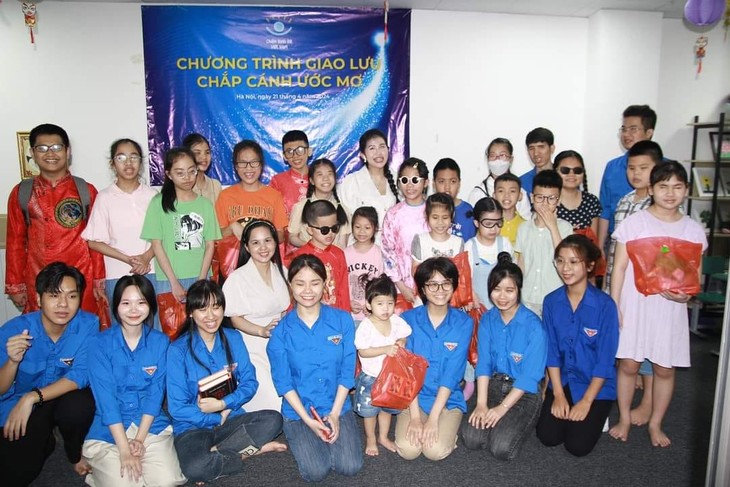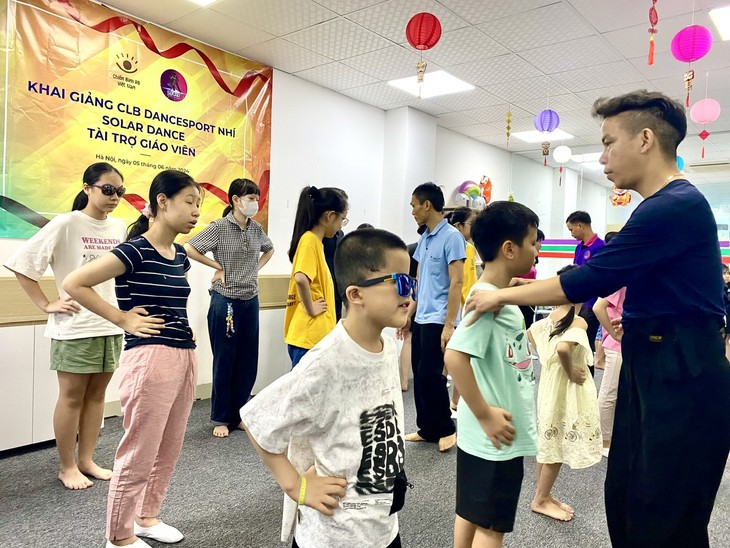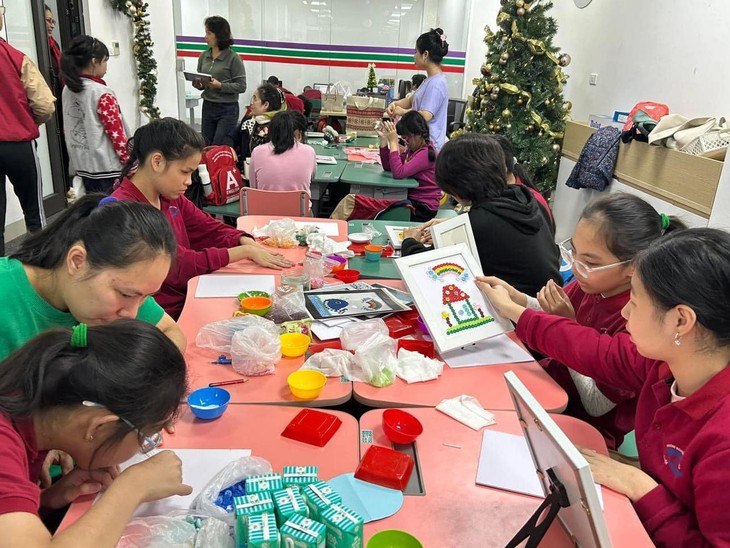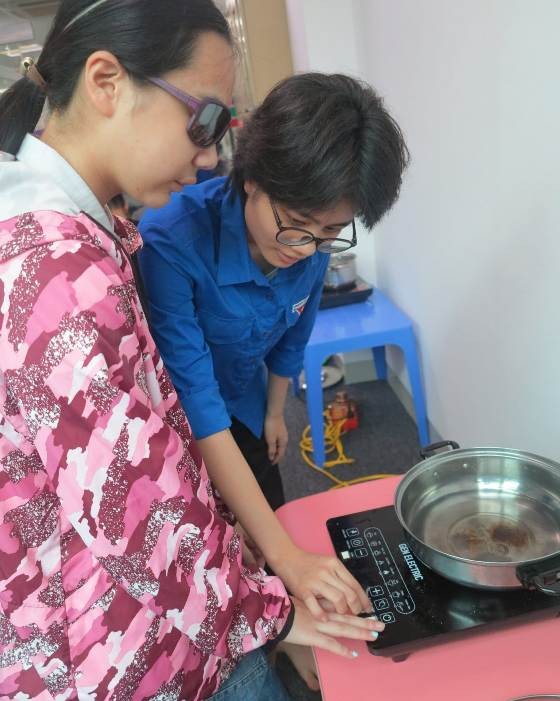(VOVWORLD) - Since early June this year, the RB Club for blind and visually impaired children in Hanoi has been holding morning classes to teach the kids Braille, maths, navigation and mobility techniques, computer skills, singing, dancing, and making pictures using colored buttons.
 An exchange "Giving wings to your dreams" at the RB Club at 3rd Floor Tầng 3, No.7, Lac Trung street, Hai Ba Trung district, Ha Noi (photo: RB Club) An exchange "Giving wings to your dreams" at the RB Club at 3rd Floor Tầng 3, No.7, Lac Trung street, Hai Ba Trung district, Ha Noi (photo: RB Club) |
At the RB Club, which was founded by a group of doctors at the National Eye Hospital and some parents of visually impaired children in late 2023, most of the teachers and assistants are also visually impaired. RB stands for Retinoblastoma, a rare tumor of the eye that usually develops in early childhood, typically before the age of 5.
Doctor Pham Minh Chau, Deputy Head of the Department of Children’s Eyes of the National Eye Hospital, said: "If the children are diagnosed with retinoblastoma by the age of 2 and receive proper treatment, they can be cured, and might grow up with decent vision. Poor eyesight makes it very difficult for a child to integrate into community. Education can help them have a better life. Initially we had a small fund for patients receiving retinoblastoma treatment. Because it’s a rare disease with a very small number of patients, we used the fund to open the RB Club for children with all types of visual impairments.”
 Doctor Pham Minh Chau, Deputy Head of the Department of Children’s Eyes of the National Eye Hospital, (in floral dress) and volunteers at the RB Club. (photo: RB Club) Doctor Pham Minh Chau, Deputy Head of the Department of Children’s Eyes of the National Eye Hospital, (in floral dress) and volunteers at the RB Club. (photo: RB Club) |
The RB club has since attracted a number of vision-impaired children. For their parents, this is place where the children can develop their ability and creativity and where they can share their stories about nurturing the children.
“My son is an 8th grade pupil at Nguyen Dinh Chieu School for the Blind. He loves to play football and is quite happy and independent. I was introduced to this Club by a friend earlier this year. My son comes here to study computer skills. He has never used a computer before. I just bought one for him and the teacher helped him install software so he can use it at home. He has a good memory and learns quickly by himself.”
“I take my grandson to the pre-school class to learn Braille before he enters 1st grade this year. He likes singing and music, so he also joined the singing and DanceSport class. He was born without eyes. My family gives him much love and care. We brought him from Nghe An province to Hanoi for treatment and better educational opportunities. The teachers and parents at the RB Club say we should let him be more independent and do things like serve food and bathe himself.”
“My two younger sisters study here. The older one is 13 and the younger one will enter 1st grade this year. The younger girl attends classes all week – Braille, singing, dancing, and life skills. The older girl chose to study just computer skills and DanceSport. They are both very excited.”
 Coach TO Van Hoa guide the children through dance motions. (photo: Cam Thi/ VOV5) Coach TO Van Hoa guide the children through dance motions. (photo: Cam Thi/ VOV5) |
The DanceSport class has about 30 students. Coach To Van Hoa, a 38-year-old DanceSport athlete, goes around the class repeating the instructions so every child can hear. Several volunteers, some with normal vision and some who are visually impaired, hold the children’s hands and guide them through the dance motions.
After two lessons the children are beginning to look more flexible and comfortable with dancing.
"I like dancing. The teacher speaks clearly so we can follow his instructions."
"It’s fun. I like music. A volunteer helps me with the movement."
Teacher To Van Hoa has been teaching free dancing for visually impaired people since 2019. Hoa said three years ago he joined a training project for visually impaired people. After the project’s dance class ended, his trainees said they really wanted to continue dancing. Hoa was moved by their earnestness and decided to continue working with them.
“I tried to put myself in their shoes. I try to understand what they need to hear to move correctly. In a normal class, I model the movement and they copy me and correct themselves. With visually impaired people, I can't do that. I have to do hands-on training to show them how to move. I can’t ask them to hurry. I always have to be slow, and it can take several months to learn step by step how to complete a series of movements.”
Thanh Nga, a volunteer at the RB Club, is visually impaired and was once a pupil at Nguyen Dinh Chieu School for the Blind. Having worked on a project for the blind at the National Eye Hospital, Nga understands what the children need and is constantly thinking of new activities for them.
“At the beginning of the year, two children said they wanted to learn DanceSport. They spend the whole year learning skills. In the summer they wanted to study something fun. I'm mindful of their wishes. I asked coach To Van Hoa and he agreed to teach free of charge. When I announced the class, 30 children registered. Many people think blind children are shy and timid. But I can see that they’re passionate about DanceSport, which proves that they’re actually quite confident and active, and accept life as it is.”
 The visually impaired children make pictures by using colored buttons. (photo: RB Club) The visually impaired children make pictures by using colored buttons. (photo: RB Club) |
Early education is very important for visually impaired children’s social integration. Teacher Nguyen Thuy Nga has 30 years of experience teaching visually impaired pupils.
“In early education, children with little or no vision can read and write short Braille sentences and do simple math. Then when they go to an integrated class, they can keep up with the program. Teachers need to teach blind children every little skill, such as how to present carefully and neatly, and how to keep the paper flat, not curled up. Because they can't see anything, they learn very slowly. The teacher must be patient. The children must try hard. And the family’s care is very important. The children have to do homework or they will forget what they learned at school.”
Thanh Nga says that in the RB Club’s early education class the children are trained to be neat and careful in every activity so they can find things again. The children learn how to put on socks, open a bottle or can, use a rice cooker, and cook simple dishes.
 A visually impaired girl learns to use electric cooker. (photo: RB Club) A visually impaired girl learns to use electric cooker. (photo: RB Club) |
“I have been helping a couple in Thai Binh province since their son was 4 months old. Now he’s 2 years old. The parents decided to move to Hanoi to work because their son will receive better treatment and education there. I advised them to give him some early education so when he goes to an integrated school, he can keep up with the program. They bring him to the Club’s evening classes to learn and play with the older children. Our classes are essentially free. We only collect a small fee for snacks, milk, and little gifts for the children,” said Nga.
In the computer skills class, pupils learn with the JAWS and NVDA screen readers with the help of teacher Thanh Trung and several assistants, who are also visually impaired. Although they are struggling in their own lives, they voluntarily teach the children to share their energy and enthusiasm. The first lesson is about memorizing the keyboard and listening to the sound when they type.
“We divide them into two groups, blind and low vision. It’s difficult for visually impaired children to learn to use a computer, but if we go step by step, they can. Screen reader apps like JAWS and NVDA help them navigate to YouTube to watch or listen to music and films. They can hear the news. Some can engage with literature, history, and geography lessons.”
The RB Club invites visually impaired students and teachers to share their lessons and achievements so other children and their parents will know that despite visual impairment, children can still become happy, successful adults.
 Pictures of buttons made by RB Club's children (photo: Cam Thi) Pictures of buttons made by RB Club's children (photo: Cam Thi) |
Dr. Chau said: “The children will have no future if their parents don’t give them an education. It’s a pity because these children have normal intelligence. Because of their visual impairment, they often miss out on education between the ages of 5 and 18. That makes things difficult for their future. We hope this model will be replicated in many provinces and cities. We must be a bridge between medical care and education if we want to offer these children the best possible conditions we can.”
As the club continues to grow, its mission remains the same: to empower visually impaired children and help them realize their full potential. In a world that often overlooks those with disabilities, this club shines as a beacon of hope. It is a place where children are not defined by their impairments but celebrated for their abilities. Here, they learn that their dreams are within reach and that they are capable of achieving greatness.
And so, the story of this club for visually impaired children continues to unfold, a testament to the strength of the human spirit and the incredible power of a supportive community.